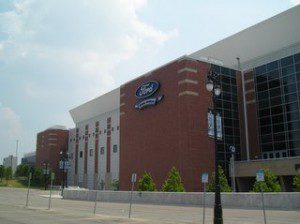 Over the past several days, there has been a lot of conversation about this year’s round of Super Bowl Commercials and whether they were worth the $2.4 Million price tag for the mere thirty seconds of air time. Frankly, I thought that this year’s crop fared better than the past couple years and actually were much better in terms of excitement and surprise than the game itself (I’m sure there are some Steelers fans who would disagree).
One of the things that struck me, however, was seeing the Ford Field signs throughout the coverage over the two weeks leading up to the game. I’m sure Ford must have felt proud that they spend the mega-millions in stadium naming fees when they saw all of the coverage. Just as they do when they watched Phil Mickelson in the FBR Open from Phoenix as he sported the Ford logo on his shirt even if he didn’t fare so well on the final 18 holes. I’m sure that GM must be proud of its title sponsorship of the Buick Opens (how many are there, anyway?)
You can’t help but wonder if these “product placements” could offset the recent bad news out of Detroit for both of these major car companies. Both announced major cutbacks and plant closing to “revitalize” these companies and their automotive brands. Do they really need the heightened awareness of seeing their names at these sporting events when Toyota has now taken over the lead as America’s most popular car brand?
Over the past several days, there has been a lot of conversation about this year’s round of Super Bowl Commercials and whether they were worth the $2.4 Million price tag for the mere thirty seconds of air time. Frankly, I thought that this year’s crop fared better than the past couple years and actually were much better in terms of excitement and surprise than the game itself (I’m sure there are some Steelers fans who would disagree).
One of the things that struck me, however, was seeing the Ford Field signs throughout the coverage over the two weeks leading up to the game. I’m sure Ford must have felt proud that they spend the mega-millions in stadium naming fees when they saw all of the coverage. Just as they do when they watched Phil Mickelson in the FBR Open from Phoenix as he sported the Ford logo on his shirt even if he didn’t fare so well on the final 18 holes. I’m sure that GM must be proud of its title sponsorship of the Buick Opens (how many are there, anyway?)
You can’t help but wonder if these “product placements” could offset the recent bad news out of Detroit for both of these major car companies. Both announced major cutbacks and plant closing to “revitalize” these companies and their automotive brands. Do they really need the heightened awareness of seeing their names at these sporting events when Toyota has now taken over the lead as America’s most popular car brand?
Seems to me that the money would be better spent convincing consumers that the Fords and Chevy’s and Buicks are worth more consideration for their auto purchases by giving some rationale as to why their cars are really good machines with great styling and great performance. I think it’s called branding. But, No, the auto marketers would rather see their money go after sponsorships and awareness – building exposure that makes them feel good, but thenleaves the car buyer opting for more Asian manufactured cars. I was dismayed to hear that Ford had decided to discontinue making the renewed Thunderbird a few months ago. Not long after it was named car of the year, the company cut back on marketing funds and left it up to the dealers to sell the cars. Meanwhile, Toyota and Lexus (Hyundai and Kia as well) consistently give us a reason to buy their cars beyond another Factory Incentive or Rebate. People stopped buying the T-Birds and now they will go the way of the Taurus and Oldsmobiles. Stick to reinforcing the brand and maybe you’ll sell more Fords.
Which brings us back to the issue of retail branding at the store. Once again the companies cut back on their branding messages and leave it up to the salespeople who still think that selling cars is the same as it was in the ‘50’s and ‘60’s by offering rebates and saying “what will it take for me to get you to deal today?” The companies need to sell more reasons to buy the car and then train their showroom personnel to help the consumer get the right car—not just sell them. It’s another retail branding problem that can’t be fixed with another employee pricing promotion ,factory incentive or $2.4 M commercial. It’s building a relationship with the customer day in day out.
RANDY CURTIS I just got back to my office and learned that a good friend and colleague, Randy Curtis had passed away suddenly yesterday. Randy was one of my frequent commentators on this blog and a real retail marketing professional. He was the creative spark behind the successful Wal-Mart campaigns over the past several years before, like me, he decided to share his knowledge with more retailers as a consultant. I just met with Randy last Friday at the Retail Advertising Conference in Chicago, where we had shared some great conversation and committed to each other that we would work together soon on a project or two. The thought of joining forces was invigorating and exciting for me. He was a great guy, a big supporter of RAMA, and a great family man . I will miss him

Recent Comments